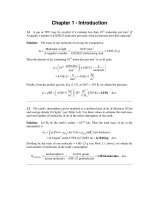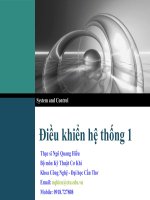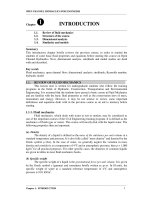Chapter 1 acid nucleic 2015813
Bạn đang xem bản rút gọn của tài liệu. Xem và tải ngay bản đầy đủ của tài liệu tại đây (4.95 MB, 164 trang )
CHAPTER 3
NUCLEIC ACID
CONTENT
Nucleoside, nucleotide, oligonucleotide
DNA, RNA
Physical & chemical properties
Modification mechanism
Biosynthesis of nucleotide
Application of molecular biology in Food
technology
Restriction enzymes
Genetic engineering
GMO (Genetically modified organism)
GMF (Genetically modified food)
Human genome
NUCLEIC ACID - HISTORY
Isolated nuclein
(from nuclei of white blood cells)
nucleic acid
Nucleic acids: polynucleotides
Friedrich Miescher (1844-1895)
Swiss physician and biologist
NUCLEOTIDE STRUCTURE
PHOSPHATE
GROUP (PO4)
NITROGEN BASE (C-N ring)
SUGAR (5C)
Ribose (RNA)
Deoxyribose (DNA)
PURINES
Adenine (A)
Guanine(G)
NUCLEOTIDE
PYRIMIDINES
Thymine (T); Uracil (U)
Cytocine (C)
NUCLEOTIDE STRUCTURE - SUBUNITS
NUCLEOTIDE STRUCTURE - BONDS
NUCLEOTIDE STRUCTURE - PENTOSE
POLYNUCLEOTIDE-BACKBONE
THE SUGAR-PHOSPHATE BACKBONE
Sugar-phosphate joined by phosphodiester bonds
Sugar-phosphate in poly nucleotide orientated in the same
direction
3’-OH group of the sugar in one nucleotide forms an ester bond to
the phosphate group on the 5’-carbon of the sugar of the next
nucleotide
POLYNUCLEOTIDE-BACKBONE
NUCLEOTIDE STRUCTURE-BASE
Bases
Attached to the 1st Carbon
of sugar
NUCLEOSIDE & NUCLEOTIDE
• Nucleoside
– consists of a nitrogen base linked to C1’ of a ribose or
deoxyribose (glycosidic bond)
– Named
• for purines: changing the nitrogen base ending: -ine to osine : adenine adenosine
• for pyrimidines: changing the nitrogen base ending (osine to
– idine: cytosine cytidine
NUCLEOSIDE & NUCLEOTIDE
• Nucleotide
– nucleoside forms a phosphate ester with the C5’-OH group of
ribose or deoxyribose
– Named: using the name of the nucleoside followed by 5’monophosphate: adenosine 5’-monophosphate
• Oligonucleotide: short nucleotide (<100 nt) (primers for DNA
replication)
NAMES OF NUCLEOSIDES AND NUCLEOTIDES
ATP - MAJOR ENERGY SOURCE FOR CELLULAR ACTIVITY
ATP: adenosine triphosphate
All cells need chemical energy carried out by ATP
Molecules in food store chemical energy in their bonds
Starch molecule
Glucose molecule
HOW DOES ATP STORE ENERGY?
Energy is stored in the last high energy phosphate
bond (it can store more energy than other types of
bonds)
The cell stores energy by bonding a phosphate to
ADP (Adenosine Diphosphate)
ATP-CHEMICAL STRUCTURE
+
+
HOW DOES CELL GET ENERGY FROM ATP?: HYDROLYSIS
H2O
By breaking the high- energy bonds
between the last two
phosphates in ATP
THE ADP-ATP CYCLE
ATP-ase
ATP
Synthetase
ATP & CHEMICAL ENERGY
Organisms break down carbon-based molecules to produce
ATP
Carbohydrates: the most commonly broken down to
make ATP
– not stored in large amounts
– up to 36-38 ATP from one glucose molecule
Fats store the most energy: 80 percent of energy in
the body
– about 146 ATP produced from a triglyceride
Proteins: the least likely to be broken down to make
ATP
– amino acids not usually needed for energy
WHEN IS ATP MADE?
During Cellular Respiration
•
•
•
Includes pathways that require oxygen
Glucose is oxidized and O2 is reduced
Glucose breakdown one molecule of glucose 3638 ATP molecules









